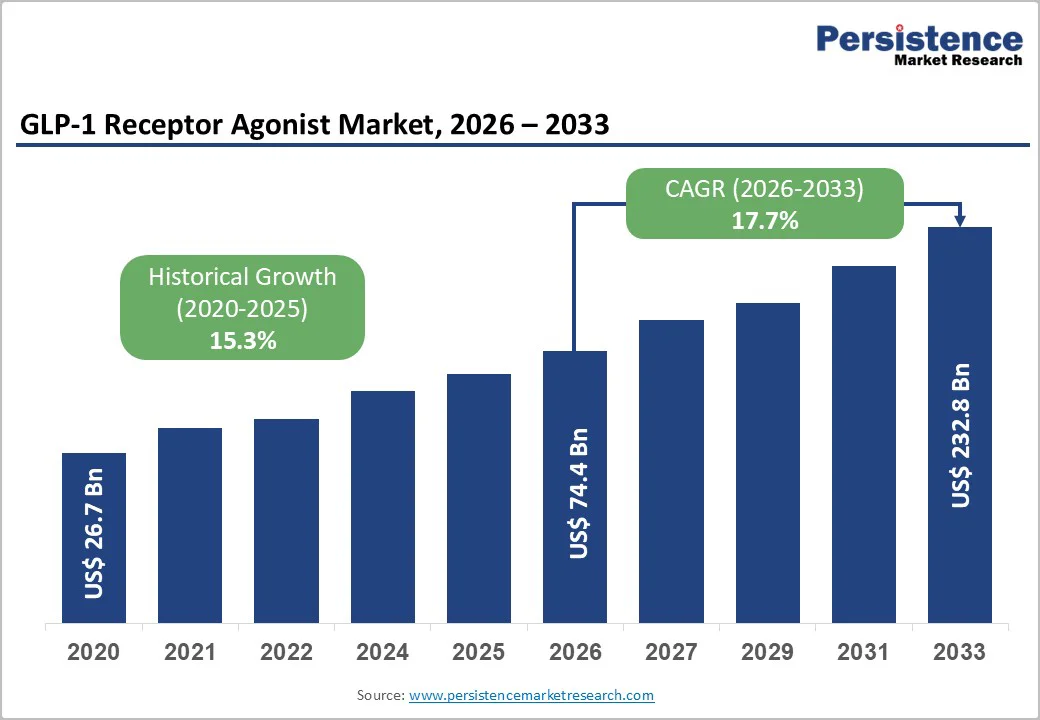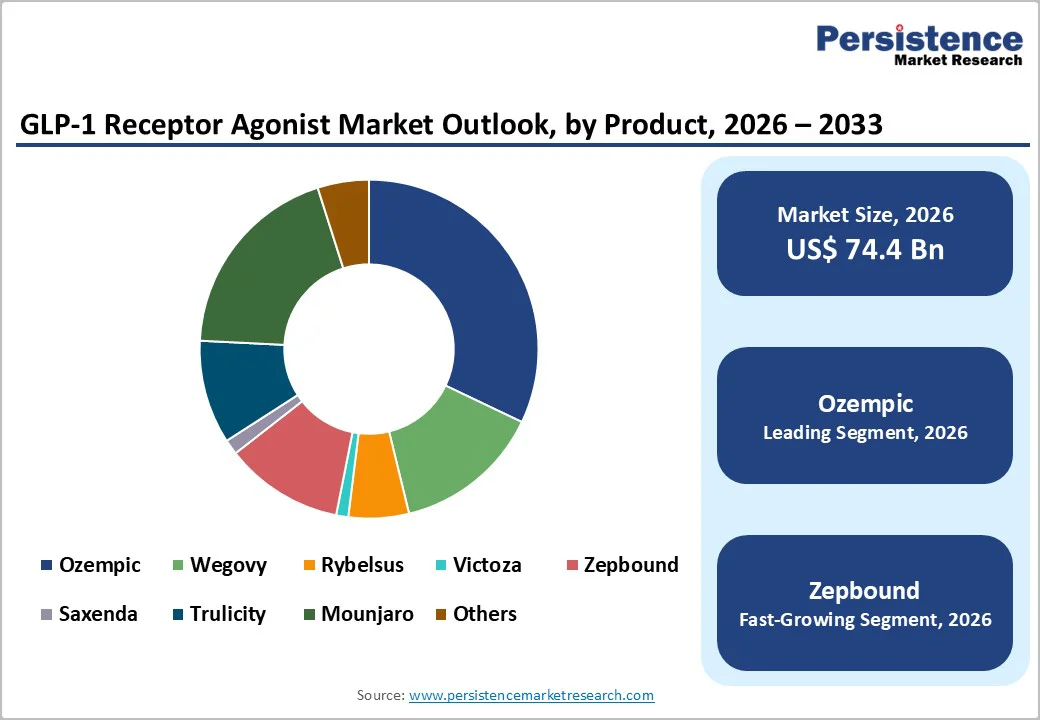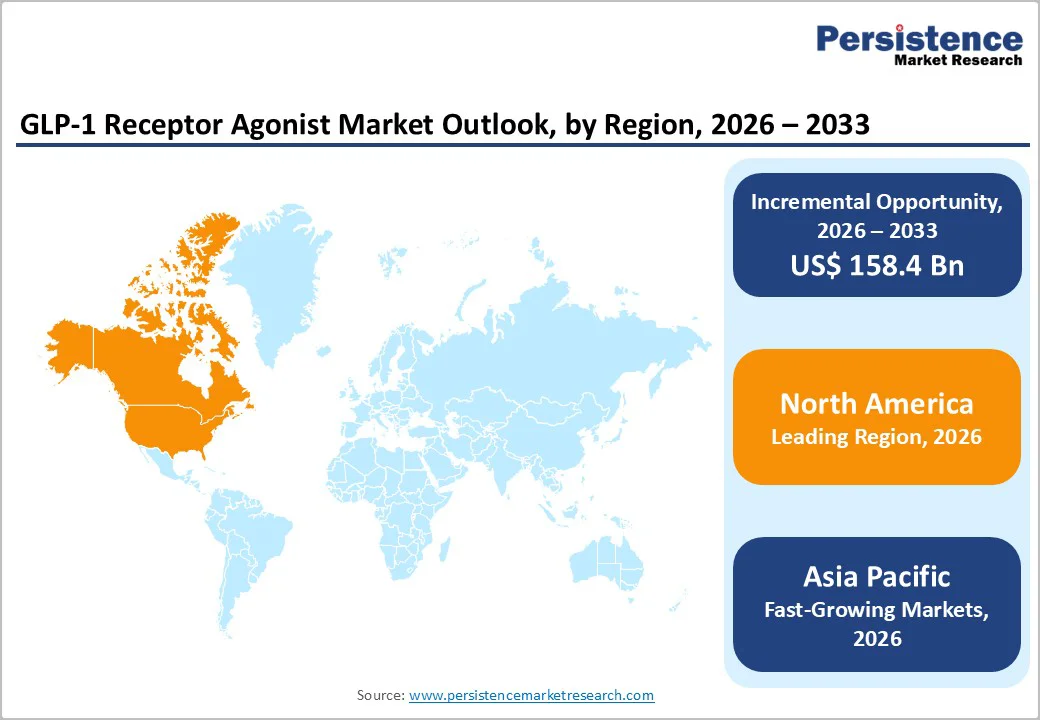ID: PMRREP34386| 210 Pages | 23 Dec 2025 | Format: PDF, Excel, PPT* | Healthcare

The global GLP-1 receptor agonist market size is estimated to grow from US$ 74.4 billion in 2026 to US$ 232.8 billion by 2033. The market is projected to record a CAGR of 17.7% from 2026 to 2033.
The GLP-1 receptor agonist market is growing rapidly, supported by rising obesity and diabetes prevalence, strong clinical outcomes, and increasing patient awareness. North America leads due to robust healthcare systems, early adoption, and reimbursement strength.
Asia-Pacific is the fastest-growing region, driven by expanding access, improving diagnosis rates, and significant investments in advanced metabolic therapies.
| Key Insights | Details |
|---|---|
| GLP-1 Receptor Agonist Market Size (2026E) | US$ 74.4 Bn |
| Market Value Forecast (2033F) | US$ 232.8 Bn |
| Projected Growth (CAGR 2026 to 2033) | 17.7% |
| Historical Market Growth (CAGR 2020 to 2025) | 15.3% |

GLP-1 receptor agonists are driving market growth due to their strong clinical outcomes in both weight loss and glycemic control. In large studies, GLP-1 therapies reduced body weight by an average of 4.57 kg, body mass index by 2.07 kg/m², and waist circumference by 4.55 cm compared with placebo. Semaglutide, a leading GLP-1 receptor agonist, demonstrated a mean weight loss of 14.9% at weekly doses of 2.4 mg, compared with only 2.4% for placebo.
In patients with type 2 diabetes mellitus, once-weekly semaglutide reduced HbA1c by approximately 1.1% and body weight by about 4.9 kg in real-world settings. These outcomes not only improve patient health and quality of life but also increase physician confidence in prescribing GLP-1 therapies.
The combination of significant weight reduction and effective glycemic control across diverse patient populations makes GLP-1 receptor agonists highly attractive, fueling their adoption worldwide and establishing them as a cornerstone in obesity and diabetes management.
The high cost of therapy is a significant restraint for the GLP-1 receptor agonist market, limiting patient access and long-term adoption. In the United States, a one-month supply of Ozempic can cost approximately $936- $1,000, while Wegovy ranges between $1,300 and $1,400 per month without insurance, translating to an annual expense of $11,000- $16,000.
Despite production costs being estimated at under $5 per month, the branded pricing creates a substantial financial barrier, especially for patients requiring chronic therapy. High out-of-pocket expenses can lead to delayed initiation, reduced adherence, or premature discontinuation, impacting therapeutic outcomes.
In emerging markets, affordability is an even greater challenge due to limited insurance coverage and lower average incomes, restricting market expansion. This pricing dynamic constrains overall market penetration and slows adoption despite the strong clinical benefits of GLP-1 therapies in weight management and glycemic control, making cost a key obstacle to broader global uptake.
The global rise in obesity presents a significant opportunity for the GLP-1 receptor agonist market. In 2022, approximately 43% of adults were overweight, and 16% were classified as obese, representing nearly 890 million people worldwide, with rates having more than doubled since 1990.
GLP-1 therapies have demonstrated substantial weight-reduction benefits, with studies showing an average weight loss of 4.6 kg, a BMI reduction of 2.1 kg/m², and a decrease in waist circumference of 4.6 cm compared to placebo. High-dose semaglutide and tirzepatide have produced even greater results in non-diabetic populations, often achieving a 10-15% reduction in baseline body weight.
As obesity is a key risk factor for type 2 diabetes, cardiovascular disease, and other metabolic disorders, effective pharmacological interventions are increasingly sought after. GLP-1 receptor agonists, offering clinically proven and durable weight-loss outcomes, are thus positioned to capture expanding demand in obesity management, driving market growth globally and complementing their use in diabetes care.
Ozempic (semaglutide) dominates with 32.1% share of the global market in 2025, due to its strong efficacy in both glycemic control and weight management. In type 2 diabetes patients, it reduces HbA1c by approximately 2.1 percentage points and lowers body weight by an average of 6.2 kg. In obese and metabolic-risk populations, higher doses have produced weight loss of up to 15% of baseline body weight.
Its once-weekly injectable regimen improves patient adherence compared with daily treatments, offering convenience without sacrificing outcomes. Combined with extensive clinical evidence and growing real-world use, these factors have driven widespread physician preference and patient adoption. The potent and reliable metabolic effects, coupled with ease of administration, make Ozempic the leading GLP-1 product globally, capturing the largest market share.
Type 2 Diabetes Mellitus (T2DM) dominates the GLP-1 receptor agonist market, with a 61.7% share in 2025, driven by its high global prevalence. T2DM accounts for more than 90% of all diabetes cases, with approximately 589 million adults aged 20-79 affected worldwide in 2024. The growing patient population creates sustained demand for effective therapies for glycemic control.
GLP-1 receptor agonists provide significant reductions in HbA1c, weight loss, and cardiovascular benefits, making them highly preferred by clinicians for long-term management. Their once-weekly dosing and favorable safety profile further enhance adherence and adoption.
Because the majority of diabetes patients have T2DM, prescribing practices and clinical guidelines consistently prioritize GLP-1 therapy for this group, ensuring that T2DM remains the leading indication driving revenue and market share within the global GLP-1 receptor agonist segment.

North America dominates the GLP-1 receptor agonist market with a 41.8% share in 2025, driven by the high prevalence of diabetes and obesity, coupled with strong healthcare infrastructure and widespread insurance coverage. In the U.S., approximately 38.4 million people, or 11.6% of the population, have diabetes, with millions more pre-diabetic or overweight, creating a large pool of potential GLP-1 users.
Around one in three adults with diagnosed diabetes using insulin also incorporates GLP-1 therapy, reflecting strong physician adoption and integration into standard care. Access to advanced therapies, established treatment protocols, and patient awareness further support adoption.
These factors, combined with robust clinical evidence demonstrating efficacy in glycemic control and weight management, ensure North America retains the largest market share for GLP-1 receptor agonists globally.
Europe is an important region for the GLP-1 receptor agonist market due to the high prevalence of diabetes and obesity. Approximately 66 million adults in Europe currently live with diabetes, representing a substantial patient population for GLP-1 therapies. Additionally, nearly 60% of European adults are overweight or obese, increasing the risk of type 2 diabetes and metabolic complications.
The combination of high disease burden and growing awareness of effective treatments drives demand for GLP-1 receptor agonists. Strong healthcare infrastructure, established reimbursement systems, and widespread physician adoption further support market penetration. These factors, along with proven efficacy in glycemic control, weight management, and cardiovascular risk reduction, make Europe a key region for the growth and adoption of GLP-1 therapies.
The Asia-Pacific region is the fastest-growing for GLP-1 receptor agonists due to a rapidly rising burden of diabetes and obesity. The region accounts for roughly two-fifths of the world’s overweight or obese adults, totaling about 1 billion people. In 2024, the Western Pacific had approximately 215 million adults with diabetes, while Southeast Asia accounted for another 106.9 million, creating a vast potential patient pool.
Rapid urbanization, sedentary lifestyles, and changing diets have further escalated the incidence of type 2 diabetes and related metabolic disorders. Increasing healthcare access, growing patient awareness, and the adoption of advanced therapies are driving market penetration. These factors combine to make Asia-Pacific the fastest-growing region for GLP-1 receptor agonist adoption and market expansion globally.

Leading GLP-1 receptor agonist companies focus on R&D, clinical trials, and staff training, while collaborating with hospitals and research centers. They aim to enhance treatment precision, improve safety, and expand global adoption, addressing the growing demand for effective, targeted therapies in diabetes and obesity management and driving innovation and market growth worldwide.
The global GLP-1 receptor agonist market is projected to be valued at US$ 74.4 Bn in 2026.
Rising diabetes and obesity prevalence, strong clinical outcomes, patient awareness, insurance coverage, and demand for effective, convenient metabolic therapies drive growth.
The global GLP-1 receptor agonist market is poised to witness a CAGR of 17.7% between 2026 and 2033.
Expansion in obesity management, oral GLP-1 formulations, emerging market penetration, next-generation dual-agonists, and digital health integration offer significant growth opportunities.
Eli Lilly and Company, Sanofi, Novo-Nordisk A/S, AstraZeneca, Amgen, Inc.
| Report Attribute | Details |
|---|---|
| Historical Data/Actuals | 2020 - 2025 |
| Forecast Period | 2026 - 2033 |
| Market Analysis | Value: US$ Bn |
| Geographical Coverage |
|
| Segmental Coverage |
|
| Competitive Analysis |
|
| Report Highlights |
|
By Product
By Indication
By Route of Administration
By Distribution Channel
By Region
Delivery Timelines
For more information on this report and its delivery timelines please get in touch with our sales team.
About Author